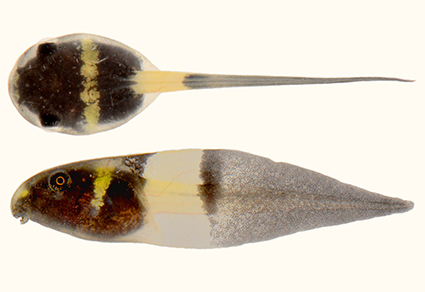Abstract
The genus Feihyla Frost, Grant, Faivovich, Bain, Haas, Haddad, de Sá, Channing, Wilkinson, Donnellan, Raxworthy, Campbell, Blotto, Moler, Drewes, Nussbaum, Lynch, Green & Wheeler was established relatively recently (Frost et al. 2006), but to date its composition has changed several times due to the extremely confusing and labile systematics of small rhacophorids (e.g., Grosjean et al. 2008; Hertwig et al. 2013; Biju et al. 2020). It embeds rather miniature, delicate tree frogs and currently comprises six species (Frost 2023). The type species, Feihyla palpebralis (Smith 1924), was described from Mount Langbian in the southern part of the Truong Son Range (Annamite Mountains) and was long considered endemic to Vietnam; recent reports that it is also distributed in China can be based on misidentification and need reliable confirmation (Biju et al. 2020).
References
- Altig, R. (2007) A primer for the morphology of anuran tadpoles. Herpetological Conservation and Biology, 2, 71–74.
- Biju, S.D., Garg, S., Gokulakrishnan, G., Sivaperuman, C., Thammachoti, P., Ren, J., Gopika, C., Bisht, K., Hamidy, A. & Shouche. Y.S. (2020). New insights on the systematics and reproductive behaviour in tree frogs of the genus Feihyla, with description of a new related genus from Asia (Anura, Rhacophoridae). Zootaxa, 4878 (1), 1–55. https://doi.org/10.11646/zootaxa.4878.1.1
- Das, I., Hedeir, H., Pui, Y.M., Hertwig, S.T. & Haas, A. (2016) Larval external morphology and development in Feihyla kajau (Dring, 1983) (Amphibia: Anura: Rhacophoridae). Raffles Bulletin of Zoology, 64, 319–328.
- Frost, D.R. (2023) Amphibian Species of the World: an Online Reference. Version 6.1. American Museum of Natural History, New York. Electronic Database accessible. Available from: https://amphibiansoftheworld.amnh.org/index.php (accessed 22 August 2023)
- Frost, D.R., Grant, T., Faivovich, J., Bain, R.H., Haas, A., Haddad, C.F.B., de Sá, R.O., Channing, A., Wilkinson, M., Donnellan, S.C., Raxworthy, C.J., Campbell, J.A., Blotto, B.L., Moler, P.E., Drewes, R.C., Nussbaum, R.A., Lynch, J.D., Green, D.M. & Wheeler, W.C. (2006) The amphibian tree of life. Bulletin of the American Museum of Natural History, 297, 1–370. https://doi.org/10.1206/0003-0090(2006)297[0001:TATOL]2.0.CO;2
- Gosner, K.L. (1960) A simplified table for staging anuran embryos and larvae. Herpetologica, 16, 183–190.
- Grosjean, S. & Inthara, C. (2016) Molecular identifications and descriptions of the tadpoles of Rhacophorus kio Ohler & Delorme, 2006 and Rhacophorus rhodopus Liu & Hu, 1960 (Amphibia: Anura: Rhacophoridae). Zoosystema, 38, 267–282. https://doi.org/10.5252/z2016n2a5
- Grosjean, S., Delorme, M., Dubois, A. & Ohler, A. (2008) Evolution of reproduction in the Rhacophoridae (Amphibia, Anura). Journal of Zoological Systematics and Evolutionary Research, 46, 169–176. https://doi.org/10.1111/j.1439-0469.2007.00451.x
- Haas, A. (2003) Phylogeny of frogs as inferred from primarily larval characters (Amphibia: Anura). Cladistics, 19, 23–89. https://doi.org/10.1111/j.1096-0031.2003.tb00405.x
- Haas, A., Das, I., Hertwig, S.T., Bublies, P. & Schulz-Schaeffer, R. (2022) A Guide to the Tadpoles of Borneo. Tredition GmbH, Hamburg, 553 pp.
- Hendrix, R., Grosjean, S., Le, Q. K., Vences, M., Vu, T. N., & Ziegler, T. (2007). Molecular identification and description of the tadpole of the Annam Flying frog, Rhacophorus annamensis Smith, 1924 (Anura: Rhacophoridae). Salamandra, 43, 11–19.
- Hertwig, S.T., Schweizer, M., Das, I., & Haas, A. (2013) Diversification in a biodiversity hotspot—The evolution of Southeast Asian rhacophorid tree frogs on Borneo (Amphibia: Anura: Rhacophoridae). Molecular Phylogenetics and Evolution, 68, 567–581. https://doi.org/10.1016/j.ympev.2013.04.001
- Heyer, W.R. (1971) Description of some tadpoles from Thailand. Fieldiana Zoology, 58, 83–91. https://doi.org/10.5962/bhl.title.3067
- Inger, R.F., Orlov, N.L. & Darevsky, I.S. (1999) Frogs of Vietnam: a report on new collections. Fieldiana Zoology, 92, 1–46.
- Kerney, R., Meegaskumbura, M., Manamendra-Arachchi, K. & Hanken, J. (2007). Cranial ontogeny in Philautus silus (Anura: Ranidae: Rhacophorinae) reveals few similarities with other direct-developing anurans. Journal of Morphology, 268, 715–725. https://doi.org/10.1002/jmor.10545
- Kropachev, I.I., Vassilieva, A.B., Orlov, N.L., Rybaltovsky, E.M. & Nguyen, T.T. (2021) First description of the tadpole of Kurixalus baliogaster (Inger, Orlov, and Darevsky, 1999) (Anura: Rhacophoridae) from Vietnam, with comments on reproductive biology. Zootaxa, 5039 (1), 144–148. https://doi.org/10.11646/zootaxa.5039.1.9
- Kusrini, M.D., Lubis, M.I., Darmawan, B. & Rahman, L.N. (2017) Morphological and ecological observation on Chiromantis vittiger (Anura: Rhacophoridae) in Mount Halimun-Salak National Park, Indonesia. Treubia, 44, 47–66. https://doi.org/10.14203/treubia.v44i0.3246
- Meegaskumbura, M., Senevirathne, G., Biju, S.D., Garg, S., Meegaskumbura, S., Pethiyagoda, R., Hanken, J & Schneider, C.J. (2015) Patterns of reproductive-mode evolution in Old World tree frogs (Anura, Rhacophoridae). Zoologica Scripta, 44, 509–522. https://doi.org/10.1111/zsc.12121
- Ninh, H.T., Nguyen, T.T., Pham, C.T., Nguyen, T.Q., Orlov, N.L., Rauhaus, A. & Ziegler, T. (2020) First record of the Vietnam Flying Frog, Rhacophorus calcaneus Smith, 1924, from Khanh Hoa Province, including the first molecular identification and morphological description of larval stages. Revue suisse de Zoologie, 125, 231–238.
- Ramaswami, L.S. (1938) Connexions of the pterygoquadrate in the tadpole of Philautus variabilis (Anura). Nature, 192, 577. https://doi.org/10.1038/142577a0
- Ridewood, W.G. (1898) On the larval hyobranchial skeleton of the anurous batrachians, with special reference to the axial parts. Zoological Journal of the Linnean Society, 26, 474–487. https://doi.org/10.1111/j.1096-3642.1898.tb01960.x
- Senevirathne, G., Kerney, R &, Meegaskumbura, M. (2017) Comparative postembryonic skeletal ontogeny in two sister lineages of Old World tree frogs (Rhacophoridae: Taruga, Polypedates). PLoS ONE, 12, e0167939. https://doi.org/10.1371/journal.pone.0167939
- Smith, M.A. (1924) New tree-frogs from Indo-China and the Malay Peninsula. Proceedings of the Zoological Society of London, 1924, 225–234. https://doi.org/10.1111/j.1096-3642.1924.tb01499.x
- Vassilieva, A.B., Gogoleva, S.I. & Poyarkov, N.A. Jr. (2016) Larval morphology and complex vocal repertoire of Rhacophorus helenae (Anura: Rhacophoridae), a rare flying frog from Vietnam. Zootaxa, 4127 (3), 515–516. https://doi.org/10.11646/zootaxa.4127.3.6
- Vera Candioti, F., dos Santos Dias, P.H., Rowley, J.J.L., Hertwig, S., Haas, A. & Altig, R. (2021) Anatomical features of the phytotelma dwelling, egg-eating, fanged tadpoles of Rhacophorus vampyrus (Anura: Rhacophoridae). Journal of Morphology, 282, 769–778. https://doi.org/10.1002/jmor.21348
- Wassersug, R.J. (1976). A procedure for differential staining of cartilage and bone in whole formalin-fixed vertebrates. Stain Technology, 51, 131–134. https://doi.org/10.3109/10520297609116684
- Wildenhues, M.J., Bagaturov, M.F., Schmitz, A., Tran, D.A.T., Hendrix, R. & Ziegler, T. (2011) Captive management and reproductive biology of Orlov’s treefrog, Rhacophorus orlovi Ziegler and Köhler, 2001 (Amphibia: Anura: Rhacophoridae), including larval description, colour pattern variation and advertisement call. Der Zoologische Garten, 80, 287–303. https://doi.org/10.1016/j.zoolgart.2011.10.002


